This site contains affiliate links. As an Amazon Associate, I earn a commission from qualifying purchases at no extra cost to you. Full Disclosure Here.
The tanto blade shape is without a doubt one of the most unique and misunderstood blade shapes. It’s also one of our favorites here at Marine Approved, and by the end of this article, you’ll know exactly why.
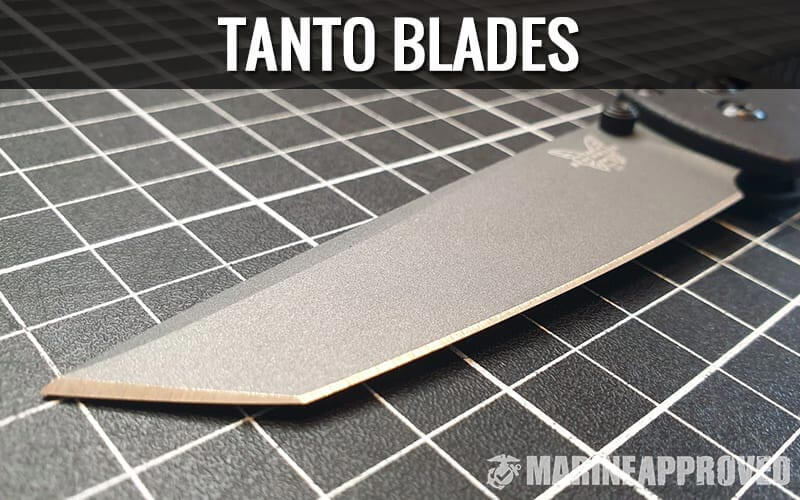
Many mistakingly see the tanto blade as a Japanese gimmick that has only one real use, piercing stuff better than some of the other blade shapes. The tanto shape, however, is much more than that. By the end of this guide, you’ll know exactly what the tanto is, the differences between the original version of the tanto and the American version of the tanto, and finally, the use cases and performance of the tanto blade shape.
Most of this guide will focus on the Americanized version of the tanto because that’s what is most popular among the western consumer market for both pocket knives and fixed blades and, honestly, because they’re dang cool and great blades to own.
Before we get into the nitty-gritty, it’s important to note that, just like all of the other blade shapes, the other factors of geometry apply here and will change how the blade behaves. If you’d like to learn more about the grind of a blade, check out our knife grinds guide here. Just like the grind, the actual steel composition of the blade will also dictate its performance across use cases, and as such, if you’d like to brush up on some of the most common knife steel types, refer to our blade steels guide here.
American Version vs Japanese Version of the Tanto Blade
America has a long history of learning cool stuff from other countries and then, well, Americanizing it. It’s no surprise that the original knife enthusiast Americans that came across the Japanese tanto thought it was awesome but also thought it needed a bit of tweaking to fully encompass their vision of what a tanto should be.
Now, one isn’t better than the other, but they do certainly have their own pros, cons, and use cases and it’s important to know the difference.
The Tanto Blade Shape Explained (American Version)
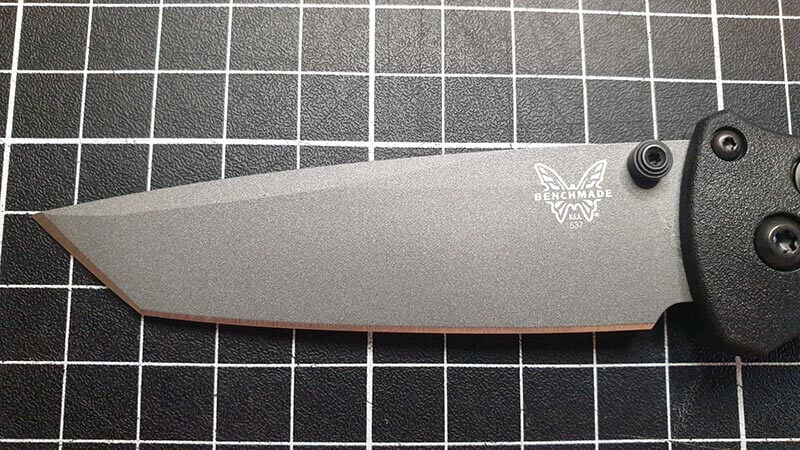
The Western version sometimes dubbed the American version or the “geometric tanto”, has a very edgy look and feel (no pun intended). It’s no wonder this blade shape has so many opinions surrounding it, as it often stands out when set next to most of the other blade shapes, and to be honest, many people would agree that it has this tacticool feel to its design in comparison with the boring old drop point.
The American tanto has a primary point where the cutting surface immediately shoots down straight or very close to being straight, where there is a secondary point. At this secondary point, the blade takes a harsh turn, sometimes even 45 degrees, and shoots back to the handle in a flat or near-flat manner. The spine of the blade is typically flat or very close to being flat and, from the handle, elegantly reaches out to that initial point.
If you’d like to check out a Westernized tanto being made here.
Yes, this means the Americanized tanto actually has two points and two edges, even if the spine isn’t sharpened. Does this count as a double-edged blade? Well, that depends on your lawmakers, but to most people in the knife industry, technically no, but also yes. When sharpening the Americanized tanto, one would sharpen both the edge between the two points and the edge between the secondary point and the handle separately as to avoid rounding off that secondary point. Here’s a video guide for sharpening a tanto blade.
In operation, the edges typically have two different uses. For example, that front edge between the two points actually makes for an excellent box and letter opener. I know, the tanto is usually talked about in terms of combat and its excellent capability to be violent in a piercing mannerism, but in all honestly, I really feel like the tanto is used more to open things up with precision than anything else for your average everyday knife user. The second edge between the secondary point and the handle makes for a really good cutting and slicing surface which is almost as utilitarian as the drop point or clip point.
Speaking of piercing capability, Cold Steel and their excellent marketing department really pounded home the idea of the Americanized tanto being an excellent piercing capable blade shape. They aren’t wrong, although I imagine that a very small amount of people that buy these, especially in a folding knife, actually require a hefty piercing-capable blade. What makes the tanto so great at piercing is that geometric tip, where the tanto blade is typically very thin yet incredibly strong and durable, allowing it to pierce much deeper with less effort than your regular drop point or many of the other popular blade shapes.
It’s been widely talked about, even on other pages here on Marine Approved, that the Western version of the tanto has exceptional performance when up against an attacker who is wearing thick clothing, like a heavy winter coat, or even an assailant in combat wearing soft body armor. The tanto has garnered quite a reputation for its ability to cut through and even pull itself within these materials, making this blade shape one of the more lethal options.
So, yes, the tanto is a lethal and capable blade shape in terms of self-defense and combat, and yes, the tanto is very much so a utility blade shape as well, coming in especially handy when opening boxes or making precise cuts, and even slicing. It’s also true that Cold Steel pounded home the idea that these bad boys can pierce a car hood, because, you know, that’s why we EDC knives, right? Check out some serious tanto carnage with Cold Steel here:
The Original Japanese Version of the Tanto Blade Explained
The Japanese version, which would be considered the original and/or traditional version, looks a lot more like a cross between a trailing point and a drop point blade, where the spine of the blade is somewhat flat until nearing the tip where it swoops up to meet the point that’s created by a belly that also dramatically swoops up. This creates a very precise but rather strong tip and cutting edge that’s excellent for both combat-related use cases but is also very usable in a utilitarian form factor as well.
If you’d like to check out a timelapse of a Japanese Tanto Sword being crafted here’s a video.
Tanto Blades Use Case Assessment: Benefits and Drawbacks
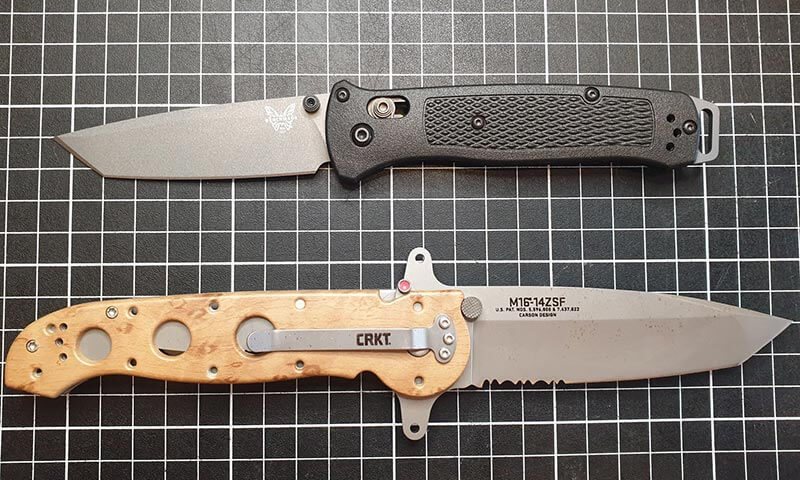
These are simply our opinions after using a myriad of different knives with different blade shapes over the years. If you’d like to check out a more comprehensive guide on all knife blade types here! In this section, we’ll be discussing what tanto blades are good for as well as their benefits and drawbacks.
Tanto Blades for Slicing and Skinning
Score: 8/10
Sure, the tanto is most well-known for its piercing capability but the truth is, a tanto with a hollow grind is going to slice and skin just as well as any other blade shape, perhaps even better than most. The tanto offers exceptional control has a massive razer sharp cutting surface that makes slicing and skinning an absolute breeze after a slight learning curve.
Tanto Blades for Stabbing and Puncturing
Score: 10/10
This is the bread and butter of the western tanto and as such, it’ll get a solid 10. If you don’t agree, just please check out that video I linked to earlier where you can see a western tanto equipped knife easily piercing through a car hood. Why would you need that? Man, I have no idea, but the tanto also has quite the reputation of piercing body armor as well, something that most other blade shapes, except maybe select clip points, can claim. Here is a quick video of a western tanto making quick work of some IIIA armor.
Tanto Blades for Batoning
Score: 6/10
Okay, so both versions of the tanto aren’t really designed for this sort of thing, and in most cases, the grind of the blade is going to be something that focuses on slimness and overall having a low amount of friction for easy penetration, which would make it a bit weak for heavy batoning, however, a tanto with a thick and heavy grind will perform just as well as anything else, like a drop point, for batoning, so long as the blade stock is nice and thick and you get a model that is large enough for this sort of thing.
Tanto Blades for Slashing
Score: 10/10
In terms of slashing for blade shapes, the tanto is going to be one of the best in the business. Simply put, the tanto encompasses a razer sharp pinpoint tip for initial penetration with a large, razor-sharp, and often thin ground cutting edge that allows for the blade to easily glide through most materials with relative ease.
Tanto Blades for Whittling
Score: 6/10
The tanto certainly is usable for whittling, no doubt, but it’s not really designed for this sort of thing. Of course, that initial cutting edge near the tip does offer some pretty intense control, especially if you choke up on the blade real tight and let that smaller edge get to work, but for the most point, a drop point or clip point is probably going to be your better choices if this is your primary use case for the knife as a whole.
Tanto Blades for Prying
Score: 2/10
No knife is truly meant to be used as a pry tool, although some blade shapes accompanied by thick and heavy grind styles can get the job done if needed in a pinch. The tanto, both the traditional and western versions, are not one of those blade shapes. If you pry heavily with a tanto, especially one with a hollow grind, you’re going to have a bad day.
Tanto Blades for Everyday Carry (EDC)
Score: 9/10
I might catch some flak for this, and at first, I was surprised too, but a nicely designed tanto that’s light and thin makes for a fantastic EDC blade shape. I have EDC’d a tanto for years now and I find almost no regular day-to-day task where I find myself wishing I had loaded out with one of my drop points. Simply put, the tanto provides excellent utilitarian value and is well versed for just about any normal task life may throw at you. I can put a tanto to work, easily cutting through speaker wire or thick cardboard, I can use my tanto to pierce a soda can and drink it like a hooligan, I can deploy my tanto in a self-defense situation and allow its exceptional ability to cut through thick clothing to protect me, and I can take it with me after work immediately to the lake and deploy it for any fishing-related knife activity that I may need. Overall I think tanto blades are great for EDC knives.
Tanto Blades for Camping/Bushcraft
Score: 5/10
As far as camping goes, a strong and relatively thick tanto, like something found on the Benchmade Nimravus or the Cold Steel Recon series is going to perform just about as well as a drop point or clip point, but for the most part, the blade shape isn’t really designed for bushcraft and sometimes that geometric shape is more of a hindrance than it is helpful. I wouldn’t necessarily say it’s useless, if it’s all you happen to have with you then so be it, it’ll do fine for most tasks around the campsite, but I wouldn’t buy a tanto if the knife itself is primarily going to be used in this manner.
Tanto Blades for Fishing Line/Ropes
Score: 9/10
A tanto with a bit of serration on the blade and you have yourself a blade shape that’s as good as any for both making quick work of fishing line itself and also cutting its way through some very thick and cumbersome rope. What I really like about the western tanto specifically is that you can choke up on the blade and utilize the smaller cutting edge to get a very nice and tight cut and even push down on the spine to get a quick slice on a piece of line lying flat on a hard surface but you can also let that huge and razor-sharp belly gnaw its way through even some of the toughest and thickest rope.
Tanto Blades for Self Defense
Score: 10/10
In terms of blade shapes there really isn’t any specific blade shape perfect for each and every encounter and all of its specific conditions and nuances but for the most part, if I were to choose a blade shape specifically to carry for self-defense or to issue to my daughter, a western tanto from a reputable brand would be my first thought. The western tanto has an insanely strong tip accompanied usually by a rather thin overall blade which makes piercing and tearing through clothing and, unfortunately, if the circumstances warrant it, flesh, making the western tanto a very lethal and relatively easy blade shape to utilize in a fast pace quick reaction defensive scenario. In our self defense knife guide, you’ll see many utilize the tanto blade shape.
Tanto Blades for First Response/Egress
Score: 8/10
The western tanto has several advantages to being used as a first response knife due to its obvious ability to pierce through even somewhat thick metal but to also be choked up on and used precisely in situations where you have to do a little blade work near a patient or trapped individual. From slashing seat belts to plowing through drywall to cutting through clothing, the western tanto is an excellent tool to have.
Tanto Blades for Combat/Tactical
Score: 9/10
As mentioned many times already by this point, the western tanto has an insanely strong tip accompanied by a blade that’s meant to be razor-sharp but very thin, allowing for easy entry into an enemy combatant, even with clothing or low-level soft body armor, and allows for quick damage to be applied in a low friction but devastating manner. Of course, most knives carried by soldiers aren’t actually used for violence, and in that case, the tanto is still an excellent tool to be used for survival, setting up camp, weapon or gear maintenance, triage, etc. When it comes to combat knives, the tanto blade shape is one of my favorite.
Tanto Blades for Cooking
Score: 7/10
A tanto isn’t exactly the first blade shape that comes to mind when I need something to cook up dinner at camp, but it is a knife that will perform well regardless. A western tanto true to its design is going to encompass a very sharp edge with a hollow grind, meaning that the long cutting surface is going to slice just about anything with relative ease and that edge at the forefront makes working with small or tough pieces of meat very easy and nimble.
Blade Shape Use Case Assessment Table
| Use Case | Overall Score |
| Slicing and Skinning | 8 out of 10 |
| Stabbing and Puncturing | 10 out of 10 |
| Batoning | 6 out of 10 |
| Slashing | 10 out of 10 |
| Whittling | 6 out of 10 |
| Prying | 2 out of 10 |
| Everyday Carry (EDC) | 9 out of 10 |
| Camping and Bushcraft | 5 out of 10 |
| Fishing Line and Ropes | 9 out of 10 |
| Self Defense | 10 out of 10 |
| First Response and Egress | 8 out of 10 |
| Combat and Tactical | 9 out of 10 |
| Cooking | 7 out of 10 |
Tanto Versus Other Popular Blade Shapes
In this article we’ll discuss the pros and cons of the tanto blade shape compared to many other popular blade shapes.
Tanto vs Drop Point Blades
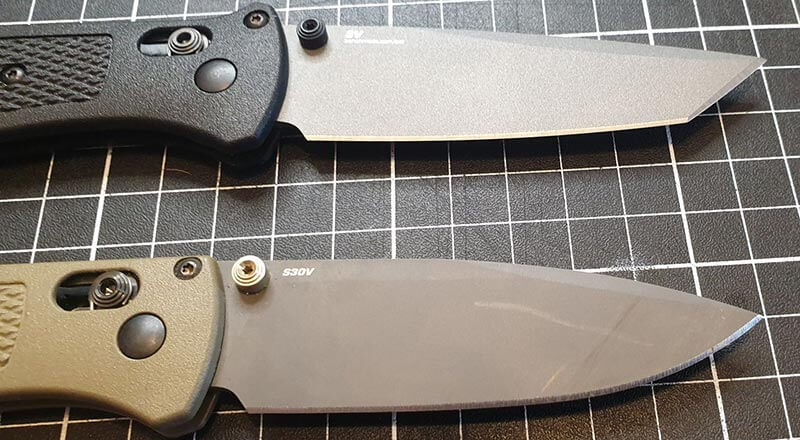
These are actually a lot more similar than most people care to admit. For the most part, the only real difference is around the tip area. Of course, drop points have a wider variety of grinds and often more options in terms of designs, but given the grind to be the same across both, they are almost identical in performance across the board, with the tanto being slightly better for piercing and the drop point is slightly better for carving/whittling. I’d say these two are the heavy choice in terms of modern EDC and to be frank, I can’t make the decision for you as I think it really comes down to personal preference and whether or not you are willing to take more time to sharpen the tanto, as the drop point would be obviously easier to maintain.
Tanto vs Reverse Tanto
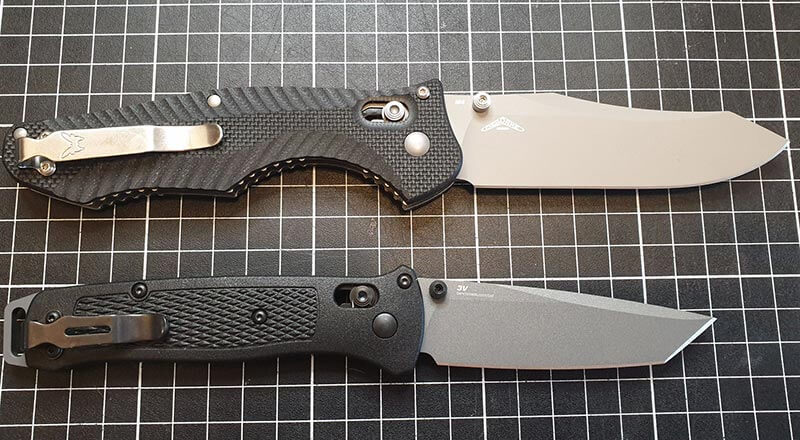
The reverse tanto in actual performance behaves a lot like a drop point with the only real difference being the geometry of the spine near the tip, making it better for penetration, so in reality, against either the drop point or the tanto, they are all going to feel about the same in almost all tasks. The reverse tanto does take out the need to sharpen two edges separately and it does offer, what some would argue, the best of both worlds between a drop point and a tanto, and that’s true, but in the real world, it’s difficult to actually discern between the two in real operation. Personally, I enjoy both, and I think this comes down to personal preference.
Tanto vs Clip Point
Another heavy hitter when it comes to piercing capability, the clip point is going to be similar to the tanto in its overall utilitarian uses but embodies a similar idea in piercing whereas the tip has as little material as possible to be low friction but still remains to be relatively strong. All in all, I think the geometry of the tanto, given the same amount of material and steel type, the western tanto is a bit strong and more reliable in terms of heavy use penetration and stabbing situations. For around the campground or as an EDC option, I’d say the differences are going to come down to personal preference yet again, as the clip point will behave more like a drop point, but the differences are pretty much null as the tanto can do basically anything the clip can.
Tanto vs Trailing Point
The trailing point is basically what the original tanto was, but compared to the western version, there are some pretty stark differences. Of course, the trailing point makes for an excellent slasher but it lacks overall strength with it comes to both horizontal force and piercing capability.
Tanto vs Wharncliffe
The western Tanto, while using just the initial edge near the front tip, almost acts like a Wharncliffe in some ways, but then also offers the additional cutting surface of its belly. Of course, the Wharncliffe makes for a great slasher, which I’d say is about on par with the tanto, but the tanto would far exceed the penetration and stabbing capabilities of a typical Wharncliffe.
Popularity and Accessibility of the Tanto
In 1981 a crazy but genius bladesmith named Bob Lum delivered to the world the first westernized tanto and from there, many brands like Cold Steel, Kershaw, Benchmade, Civivi, Ka-Bar, etc have taken to the drawing board to create their own ominous ultra-piercing capable tanto blades. Some of these brands, like Ka-Bar with their 1266 fixed tanto have a hard-use combat or self-defense mentality to their design process, while others focus on the westernized tanto being an elegant tool of simplicity and utility, like Civivi with their small and elegant folding tanto, the Brazen.
It’s safe to say that, while both the traditional and western tantos certainly aren’t the most popular blade shape, taking a back seat to the drop point and clip point, they are carving their way into the markets very quickly and as more and more knife users realize their exceptional range of options and utilitarian performance, I would imagine we will see many more western tanto options available.
For now, as of writing this, there are already a ton of choices, and almost every store that sells knives is going to have some variant of a tanto blade available. Tanto blades used to be considered a radical design but now I struggle to think of a popular brand that doesn’t have at least one tanto offering.
Common Grind Types for Tanto Blades
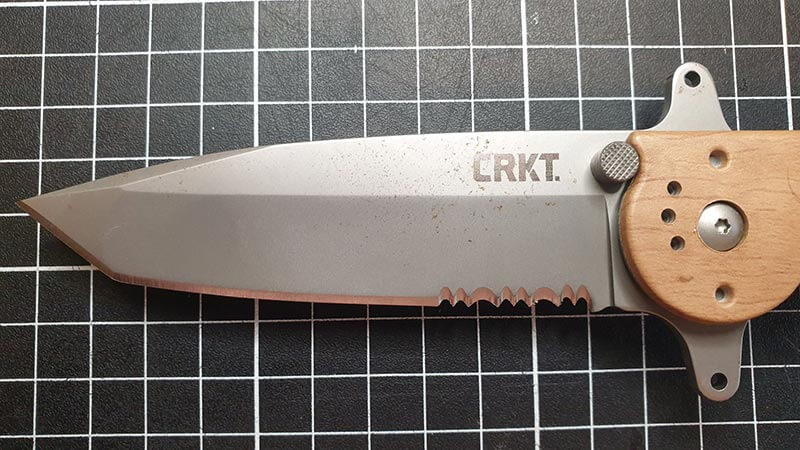
The initial idea of the westernized tanto was to create an exceptionally powerful and durable tip behind what is a rather slim and easy to penetrate form factor. Of course, a factor in achieving such results is going to be the grind, and there is no other grind than the Hamaguri grind that will give such great results.
Now, the western tanto has two points and has, technically, two edges, so why shouldn’t it have two grinds? Well, it does, usually. Of course, many brands and manufacturers have their own take on a myriad of different flavors for the tanto, but the original idea was to encompass a Hamaguri ground tip for strength with the rest of the blade being hollow ground, as to avoid any unnecessary friction when piercing or slicing.
Nowadays, as found on many Cold Steel tanto variants, it’s very popular to find a saber grind for the tips edge and a hollow or even flat grind for the rest of the blade.
Marine Approved Examples of Folding Tanto Blades (3)
- Cold Steel Recon 1 27BT
- Benchmade 537 Bailout
- Emerson CQC-7BW
Marine Approved Examples of Fixed Blade Tanto Blades (3)
- Cold Steel Warcraft
- Benchmade Nimravus
- SOG Seal FX
See a full list of our favorite fixed blade knives here. Many are available with a tanto blade.
Wrap Up
The tanto has gotten a ton of attention recently, both positive and negative, and I think that if you’re interested in trying it out that it would be advisable to ignore all the chatter and really get hands-on with it. A nicely manufactured western-style tanto is capable of affording many of the luxuries of even some of the most popular blade shapes to date, such as the drop point, but with a little more flair and attitude, which makes ownership of a western tanto blade pretty fun but also useful.
Of course, any blade shape with a shotty handle becomes more of a liability than an asset, so make sure to check out the Marine Approved guide on knife handle materials before you go shopping for a shiny new tanto-equipped blade!

